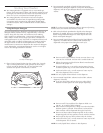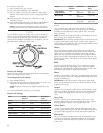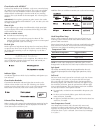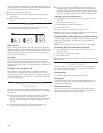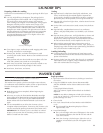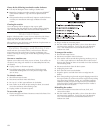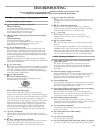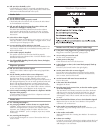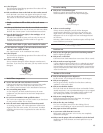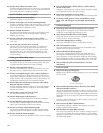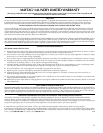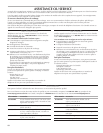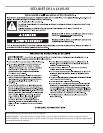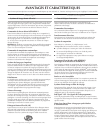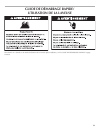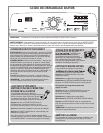
15
Is the lid open?
The lid must be closed during operation. The washer will not
operate with the lid open.
Did you add more items to the load once the washer started?
Once the load is wet, there may appear to be space for more
items. Do not add more than 1 or 2 garments after the cycle
has started. For best results, determine load size with dry items
only.
Washer continues to ll or drain, or the cycle seems
stuck
Is the top of drain hose lower than the control knobs on washer?
The top of the drain hose must be at least 39” (991 mm) above
the oor. See “Drain System” in the Installation Instructions.
Does the drain hose t too tightly in the standpipe, or is it
taped to the standpipe?
The drain hose should be loose yet t securely. Do not seal
the drain hose with tape. The hose needs an air gap. See
“Installation Instructions.”
Washer won’t drain or spin; water remains in washer
Is the drain hose clogged, or the end of the drain hose more
than 96” (2.4 m) above the oor?
See “Drain System” in the Installation Instructions.
Is the lid open?
The lid must be closed during operation. The washer will not
operate with the lid open.
Is there excessive sudsing?
Always measure detergent. Follow detergent manufacturer’s
directions. If you have very soft water, you may need to use less
detergent.
Wash/Rinse temperature
Are the hot and cold water inlet hoses reversed?
If the hot and cold water inlet hoses are reversed, the washer
will display an “HC” error code at the end of the cycle.
See “Connect the Inlet Hoses” in the Installation Instructions.
Are you washing many loads?
As your frequency of loads washed increases, the water
temperature may decrease for hot and warm temperatures.
This is normal.
Do you have an ENERGY STAR
®
qualied washer?
The wash water temperatures may feel cooler to you than those
of your previous washer. This is normal.
Does the wash water temperature feel lower than usual?
As washing progresses, the wash temperature will decrease
slightly for hot and warm washes. This is normal. To reduce
wrinkling, the warm rinse is regulated to be cooler than the
warm wash.
Excessive sudsing
Did you use a non-HE detergent?
Regular or non-HE hand-washing detergents are not
recommended for this washer. Use only HE detergent.
Is there excessive sudsing?
Always measure detergent carefully. Follow detergent
manufacturer’s directions. If you have very soft water, you
might need to use less detergent. Remember, concentrated
detergents such as 2x or higher will use less detergent based
on load size.
Selecting a Fabric Softener or Extra Rinse option will help ush
excess suds from your washer.
Clothing Care
Load too wet
Did you use the right spin speed for the load being washed?
Select a higher spin speed.
Did you use a cold rinse?
Cold rinses leave loads wetter than warm rinses. This is normal.
Did you wash an extra large load?
A large unbalanced load could result in a reduced spin speed
and wet clothes at the end of the cycle. Evenly distribute the
load and make sure the height of the load does not exceed the
top row of basket holes. Select Drain & Spin to remove excess
water from the load.
Residue or lint on load
Did you add detergent to the dispenser?
For best results, use the dispenser to dissolve the detergent.
Did you sort properly?
Sort lint givers (towels, chenille) from lint takers (corduroy,
synthetics). Also sort by color.
Did you overload the washer?
The wash load must be balanced and not overloaded. Clothes
should move freely. Lint or powdered detergent can be trapped
in the load if the washer is overloaded. Wash smaller loads.
See “Starting Your Washer” for maximum load size.
Did you use enough detergent?
Follow detergent manufacturer’s directions. Use enough
detergent to hold the lint in the water.
Did you line dry your clothing?
If so, you can expect some lint on the clothing. The air
movement and tumbling of a dryer removes lint from the load.
Was paper or tissue left in pockets?
Is your water colder than 60°F (15.6°C)?
Wash water colder than 60°F (15.6°C) may not completely
dissolve the detergent.
Did you use the proper Soil Level and Wash Cycle for the load?
Reducing wash time (duration) and wash speed are ways to
reduce lint.
Use only HE detergent.
Use only HE detergent.



